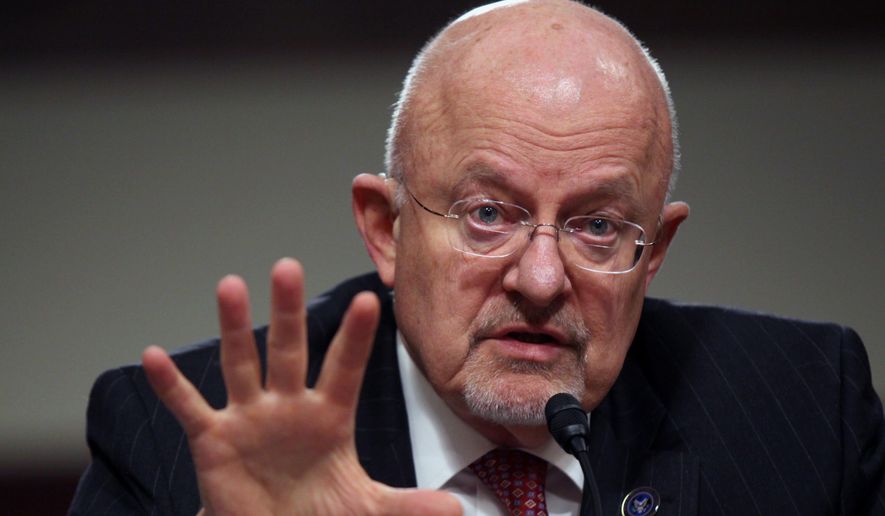President Obama’s top intelligence official pointed to a range of threats facing America Thursday, from the surge by Sunni Muslim extremist groups in the Middle East, to the pursuit of nuclear weapons by Iran and North Korea, to the push by Russian and Chinese operatives to penetrate Washington’s clandestine national security community.
But one threat was listed above all others in congressional testimony provided by Director of National Intelligence James R. Clapper — that of cyberattacks carried out by a growing host of politically, as well as criminally motivated actors against both government and private U.S. computer networks .
“Cyber threats to U.S. national and economic security are increasing in frequency, scale, sophistication and severity of impact; [and] the ranges of cyber threat actors, methods of attack, targeted systems and victims are also expanding,” Mr. Clapper said in prepared remarks to the Senate Armed Services Committee.
While the threat is complex, however, Mr. Clapper downplayed the idea America is at a high risk of having its infrastructure crippled by a major doomsday-like “Cyber Armageddon” scenario.
“The likelihood of a catastrophic attack from any particular actor is remote at this time,” he said. “We envision something different. We foresee an ongoing series of low-to-moderate level cyberattacks from a variety of sources over time, which will impose cumulative costs on US economic competitiveness and national security.”
Computer system attacks by Russian, Chinese, Iranian and North Korea operatives represent the biggest threat, the intelligence director said.
“Politically motivated cyberattacks are now a growing reality, and foreign actors are reconnoitering and developing access to U.S. critical infrastructure systems, which might be quickly exploited for disruption if an adversary’s intent became hostile,” he said. “In addition, those conducting cyber espionage are targeting U.S. government, military and commercial networks on a daily basis.”
Mr. Clapper’s remarks came as part of the intelligence community’s annual reporting to Congress on worldwide threats facing the U.S. The intelligence director’s prepared testimony is generally regarded each year as the declassified boilerplate of the intelligence community’s annual assessment of those threats.
In addition to cyber, Thursday’s threat assessment pointed to dangers associated with a variety of other developments around the globe, from Russia’s ongoing military action in eastern Ukraine, to the political and security crises in Syria and Libya, to the spread Boko Haram Islamic extremist attacks from Nigeria into Chad, Niger and Cameroon.
China’s nuclear weapons
Among the more notable passages in the assessment was one asserting that “the leading state intelligence threats to U.S. interests in 2015 will continue to be Russia and China, based on their capabilities, intent and broad operational scopes.”
The evolving nuclear weapons pursuits of Iran and North Korea were also noted — as was that of China, where the People’s Liberation Army’s (PLA’s) Second Artillery Force continues to “modernize its nuclear missile force by adding more survivable road-mobile systems and enhancing its silo-based systems,” according to the assessment.
“This new generation of missiles is intended to ensure the viability of China’s strategic deterrent by providing a second strike capability,” it stated. “In addition, the PLA Navy continues to develop the JL-2 submarine-launched ballistic missile (SLBM) and might produce additional JIN-class nuclear-powered ballistic missile submarines.”
“The JIN-class submarines, armed with JL-2 SLBMs, will give the PLA Navy its first long-range, sea-based nuclear capability,” the assessment said. “We assess that the Navy will soon conduct its first nuclear deterrence patrols.”
Islamic State threat
Mr. Clapper testified that “Sunni violent extremists are gaining momentum and the number of Sunni violent extremist groups, members and safe havens is greater than at any other point in history.”
While he said “the threat to key U.S. allies and partners will probably increase,” the intelligence director added that the growing number of the extremist groups is likely to be “balanced by a lack of cohesion and authoritative leadership.”
He also said that while “the January 2015 attacks against Charlie Hebdo in Paris is a reminder of the threat to the West,” most groups place a higher priority on “local concerns” than on attacking the so-called far enemy of the the U.S. and the West — the way that Osama Bin Laden’s original al Qaeda had been so focused during the years leading up to and immediately following Sept. 11, 2001.
But Mr. Clapper’s testimony suggested that there is still uncertainty surrounding the threat posed by the Islamic State movement, known by the acronym ISIL.
“If ISIL were to substantially increase the priority it places on attacking the West rather than fighting to maintain and expand territorial control, then the group’s access to radicalized Westerners who have fought in Syria and Iraq would provide a pool of operatives who potentially have access to the United States and other Western countries,” he said. “Since the conflict began in 2011, more than 20,000 foreign fighters — at least 3,400 of whom are Westerners — have gone to Syria from more than 90 countries.”
• Guy Taylor can be reached at gtaylor@washingtontimes.com.




Please read our comment policy before commenting.